ASRock K7VM3 - Multiplier changing function in AMI BIOS
The starting multiplier cannot be changed in the Sempron and the newer Athlon XP. However, if it is ASRock, it might be possible.
ASRock K7VM3 [ KM-266PRO ]
To know what feature Sempron CPU had, I bought this ASRock K7VM3. I thought that it was a good product though ASRock K7VM3 was cheap.

ASRock K7VM3 Specification
- CPU : Socket A / AthlonXP, Sempron, Athlon, Duron
- FSB : 200/266/333
- Chipset : VIA KM266Pro
- 2 x DDR SDRAM PC2700, 2GB max.
- 2 x E/IDE Ultra DMA/133
- 2 PCI slots , 1 AGP 4X(1.5v)
- 4+1 USB 2.0 ports
- 1 x LAN 10/100 Mbit
- 1 FD , 1 serial ports , 1 parallel port
- VGA (Integrated UniChrome graphics)
- BIOS 2Mb AMI BIOS with ACPI, SM BIOS 3.0
- Micro ATX
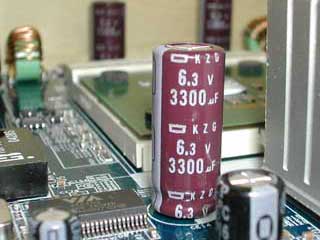
The chipset is KM-266Pro/VT-8235, and FSB333 is supported. Moreover, BIOS formally corresponds to the Sempron CPUs.
ASRock K7VM3 has the multiplier setting function when starting with 5bit jumper. However, it is invalid to the Sempron and the locked Athlon XP. As for the core voltage, only an increase of 5% and 10% was possible.
The reason to buy ASRock K7VM3 is not only a reason of low price. It is because the electrolytic capacitor of the manufacturer in Japan is used for an important part.
Special function of AMI BIOS in ASRock.
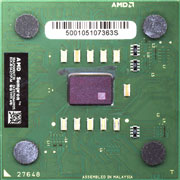
This is Sempron2500+ used to test. The manufacturing time is a core of thoroughbred B that it is 27 weeks of 2004, and CPUID was 681.
- AMD Sempron 2500+ ( SDA2500DUT3D )
- Rated frequency:1750Mhz
Rated multiplier:10.5 X (167)
Rated voltage:1.60v
It is necessary to close L5[2] of the Sempron to change the multiplier, and to change it to mobile CPU.
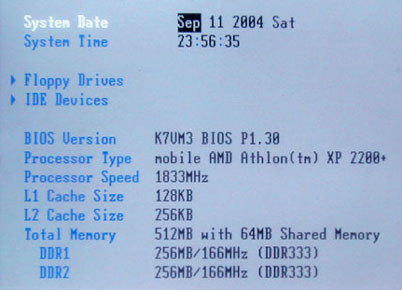
This photograph is BIOS screen of Sempron recognized as mobile CPU. It is understood that the starting multiplier is 11x, and frequency is 1833Mhz.
AMIBIOS does correct operation to the ratings multiplier of the mobile CPUs.
In general, when mobile CPU is detected, AMIBIOS detects the multiplier of the ratings from the L6 bridges. Next, AMIBIOS changes the multiplier of the CPU to the detected multiplier and boots the system. Because Sempron is CPU for desktop, the L6 bridge is not used. Therefore, it is all closed. When all L6 bridges are closed, the multiplier of ratings is recognized as 11x, and the system starts by 11x.
If you try to change the multiplier with the software such as CrystalCPUID, the maximum multiplier is decided by L6, too. Therefore, an over clock cannot be done with AMBIOS by changing the multiplier with those software.
CPU Ratio Selection of AMI BIOS
Surprisingly, the multiplier can be set by using a special function of AMI BIOS only when mobile CPU (Or, mobile-mode) is used in a part of Asrock product.

When mobile CPU is recognized in these mother boards, CPU Ratio Selection is displayed in the item of Advanced of the BIOS setting.
And, the starting multiplier can be chosen by assuming the multiplier recognized in the L6 bridge to be the maximum value.
We know that the product with this special function is the following.
- ASRock
- K7S8XE+ BIOS v1.91a
- K7VM3 BIOS v1.30
- K7VT4A+ BIOS v1.30
- K7VT6 BIOS v1.30
- K7VM4 BIOS v2.50
AMIBIOS Version '7' is used for these. Different operation might be done in the product of AMIBIOS Version '8'.
Change to the mobile CPU by closing L5[ 2 ]
In Semoron, it is necessary to close L5[2] to use a special function of AMI BIOS in ASRock. Setting the multiplier from 3x to 11X at this stage becomes possible. In addition, the maximum multiplier can set even 24x by closing L5[1].
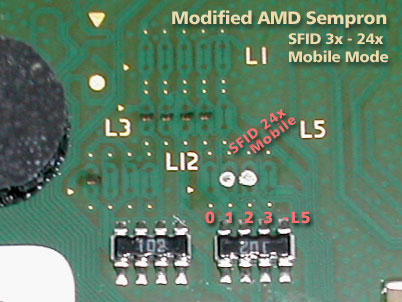
- In regular Athlon XP-M, because L5[2] is a close, this function can be used at once.
- In Athlon XP-M, if L5[1] is closed, the maximum multiplier becomes 24x.
In AMI BIOS of this Asrock, the multiplier setting can be selected from BIOS. Therefore, even if L6 is changed, it can be started by a multiplier different from the L6 multiplier. In addition, there is no problem even if L5[1] closes to adjust the maximum multiplier to 24x.
In the system of usual AMI BIOS, if L5[1] is closed, the system startup becomes impossible.
Display of CrystalCPUID
This is remodeled Semoron2500+. Please pay attention to Original Multiplier's having become 24x.
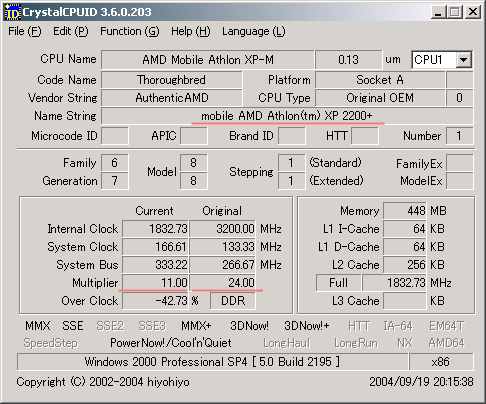
The CrystalCPUID not only detects information on CPU but also has the function to change the multiplier of the Mobile K7&K8. Please try CrystalCPUID once.
Change the multiplier in CrystalCPUID.
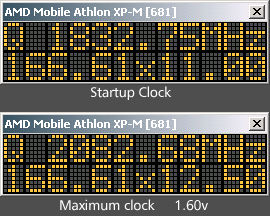
In this special AMI BIOS system, the multiplier can be freely set by using the multiplier changing function of the BIOS menu and CrystalCPUID.
To our regret, this Sempron 2500 + was not so good at an over clock.
Summary
The multiplier setting function of special AMI BIOS becomes effective because it closes the L5 bridge of Athlon XP, Sempron, and Duron (since the Morgan core). Moreover, Geode NX, Athlon XP-M, and Mobile-Duron (since the Morgan core) of mobile CPU can be used at once.
reference
- Crystal Dew World
- Please download the CrystalCPUID here.
- ASRock
- Addition of international version: 2006/07/21
- Open to the public: 2004/11/23

